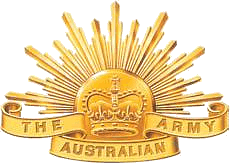List of equipment of the Australian Army
This is a list of the equipment currently used by the Australian Army.
Armoured vehicles
| Model | Image | Origin | Type | Number | Notes | |
|---|---|---|---|---|---|---|
| Armoured vehicles | ||||||
| M1 Abrams | 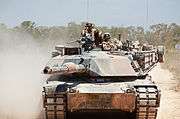 |
Main Battle Tank | 59 | 59 M1A1 Abrams and seven M88 Hercules were purchased to replace the Leopard AS1 in service with the 1st Armoured Regiment. The first M1 equipped sub-units of the regiment became operational in mid-2007. In 2016 an additional six M88A2 Hercules were acquired.[1] Beginning in around 2025 Australia is slated to upgrade its M1 fleet under LAND 907 Phase 2, which is currently the most advanced M1 Abrams variant in US service.[2] | ||
| ASLAV |  |
Eight-wheeled Armored Personnel Carrier | 257 | The Army operates 257 ASLAV-25 vehicles, in a variety of roles including formation reconnaissance, as an infantry fighting vehicle, armoured ambulance or recovery vehicle. Under LAND 400 Phase 2 the ASLAV is slated to be replaced by a new Armored Reconnaissance Vehicle (ARV) beginning in 2021. To be replaced by the Boxer (armoured fighting vehicle).[2][3][4] |
||
| M113 armoured personnel carrier |  |
Armoured personnel carrier | 431 | The Army now has 340 M113AS4 and 91 M113AS3 in service in seven variants.[5][6] The vehicles are used in the armoured reconnaissance and armoured personnel carrier roles. The Army had operated 840 M113A1 vehicles in nine variants.[5] The M113 family of vehicles is scheduled to be replaced under LAND 400 Phase 3, the Request for Tender (RfT) for which was released on 24 Ausgust 2018. Land 400 Phase 3 will replace the M113AS4s with up to 450 infantry fighting vehicles (IFVs) and 17 manoeuvre support vehicles.[7] |
||
| Boxer (armoured fighting vehicle) | 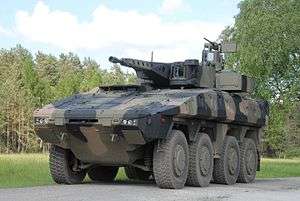 |
Multirole armoured fighting vehicle | 211 on order | 211 vehicles on order with deliveries expected to begin in 2019.[8] Part of the Land 400 Phase 2 program.[9][10] | ||
Utility, Reconnaissance and Support vehicles
| Model | Image | Origin | Type | Number | Notes |
|---|---|---|---|---|---|
| Bushmaster PMV | 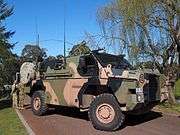 |
4×4 MRAP Cat. II | 1052 | The Army has ordered a total of 1,052 Bushmaster Protected Mobility Vehicles to date, with deliveries commencing in mid-2005. Bushmasters primarily equip the Motorised Infantry 7th Brigade, B Squadron, 3rd/4th Cavalry Regiment also operate armoured vehicles in support of the 3rd Brigade, 1st Combat Engineer Regiment, 2nd Combat Engineer Regiment, and 3rd Combat Engineer Regiment, as well as the heavy weapons and support elements of two mechanised battalions and three light infantry battalions.[11] | |
| Hawkei PMV | Armoured car | 1100 on order | The Army has ordered 1,100 Hawkei Protected Mobility Vehicles – Light (PMV-L) to partially replace the Land Rover Perentie. It is smaller and around half the weight of the Bushmaster. It is able to be carried underslung by the CH-47F Chinook helicopter.[12] | ||
| Land Rover Perentie |  |
Utility vehicle (various roles) | 5000+ | 5,000+ Land Rovers were originally acquired as a fleet of light duty vehicles for transporting stores, equipment and personnel. As of 2017 fewer than 1,500 remain in service. | |
| G-Wagen | 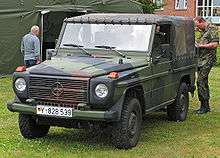 |
Multi-purpose/light assault vehicle | 2268 | The Army has purchased a total of 2,268 G-Wagons to partially replace the Land Rover Perentie. There are eight G-Wagon variants including several in a specialized 6X6 configuration, including Mobile Command Post, Surveillance and Reconnaissance, and Ambulance.[13][14][15] Some 4X4 variants are transportable by the RAAF's Alenia C-27J Spartan battlefield airlifters. | |
| RMMV HX | 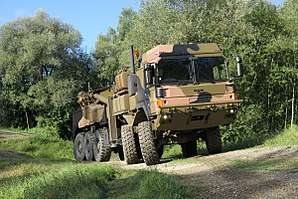 |
Tactical military trucks | 2536 | In July 2013, Rheinmetall MAN Military Vehicles (RMMV) Australia was awarded the contract for Project Land 121 (Overlander) Phase 3B. The contract is understood to have a value of AUD1.58 billion (USD1.2 billion) and called for the delivery of 2,536 medium and heavy HX and SX range trucks (later just HX), with deliveries running from 2016 and concluding in 2020. The complete order, which included 1,063 protected trucks, is made up of about 1,600 medium trucks with 4,000 to 6,000 kg payloads, about 800 heavy trucks, most with 15,000 kg payloads and some tank transporters, and just less than 100 recovery vehicles to support the fleet. Overall total and fleet breakdown have revised slightly from those stated at award date. Under a separate AUD400 million contract, 1,799 trailers will be supplied by Australian company Haulmark Trailers.
The first vehicles left RMMV's Vienna plant in July 2015. The first customer handover occurred on 7 April 2016 when six HX77 and six HX40M (plus 70 trailers) were handed over. As part of the award, RMMV Australia will also deliver almost 3,000 modules, with local partners including Sea Box Australia, which will deliver more than 2,100 flatracks for the ILHS system; Varley Group, which will supply more than 550 stores/maintenance modules; Holmwood Highgate, which will supply 276 tankers as well as water and fuel modules; and RPC Technologies, which will provide interface units for Australia's GDELS Ribbon Bridge and support boats, deliveries of which commenced in March 2018, and will conclude by September 2018.[16] Rheinmetall announced on 25 July that Australia had awarded it the LAND 121 Phase 5B contract. RMMVA will deliver more than 1000 logistics trucks and more than 800 modules to the ADF under the new program, which is an extension of the current LAND 121 Phase 3B Project. Deliveries will start in 2019 and will run to 2024.[17] | |
| HMT Extenda | 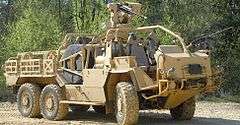 |
High Mobility Transporter | 31 | The Army purchased 31 HMT Extenda MK1 Nary patrol vehicles for use by the Special Air Service Regiment to replace the Long Range Patrol Vehicle to provide armoured protection from IEDs.[18] Its namesake comes from Warrant Officer David Nary who was the killed during pre-deployment training in Kuwait for the Iraq War. In addition, 89 HMT Extenda MK2 have been ordered for the 2nd Commando Regiment that will be reconfigurable in four configurations.[19][20][21] | |
Watercraft
| Model | Image | Origin | Type | Number | Notes |
|---|---|---|---|---|---|
| LARC-V | 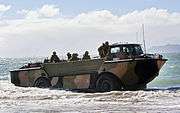 |
Amphibious cargo vehicle | 15 | 15 medium size coastal / inland waterway landing craft fitted with 2 x 12.7mm HMG to be in service until 2027.[22][23] | |
| LCM-8 | 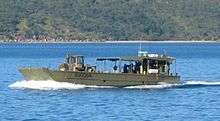 |
River boat and mechanized landing craft | 12 | 12 amphibious vehicles to be in service until 2027. Withdrawn from service in 1993 and reintroduced in 1998 after upgrade.[22][23] | |
Artillery
| Model | Image | Origin | Type | Number | Notes |
|---|---|---|---|---|---|
| M777 howitzer | 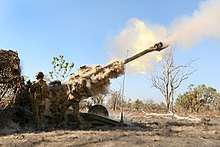 |
155mm Towed Howitzer | 54 | Thirty-five 155 mm M777s were ordered as part of the first phase of the Land 17 project to replace the Army's inventory of towed artillery, with initial deliveries beginning in late 2010.[24] An additional 19 guns were purchased in late 2012 instead of the self-propelled guns previously planned, bringing the total order to 54. | |
Air defence
| Model | Image | Origin | Type | Number | Notes |
|---|---|---|---|---|---|
| RBS 70 | 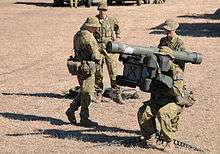 |
Short-range Air Defense (SHORAD) Man-portable air-defence system (MANPADS) |
30 | Thirty upgraded RBS-70 short range air defence weapon systems are currently divided between two Air Defence Batteries within the 16th Air Land Regiment.[25] More sophisticated Bolide missiles have now been purchased.[26] | |
| NASAMS 2 | Medium Range Surface-to-air missile | - | In April 2017 the Australian Government awarded Raytheon a contract to produce an unspecified number of NASAMS systems for use with the Australian Army.[27] The batteries, possibly mounted on Hawkei PMVs, will be used by the 16th Air Land Regiment.[28] | ||
Aircraft
| Name | Origin | Type | Number[29] | Notes |
|---|---|---|---|---|
| Airbus Helicopters ARH Tiger | Armed reconnaissance helicopter | 22 | Modified and upgraded version of the Tiger HAP. These helicopters are planned to be phased out by the mid-2020s by the formal Tiger ARH replacement project. | |
| NHIndustries MRH-90 Taipan | Medium lift/utility helicopter | 41 (+ 6 joint with Navy)[30] | Replaced the UH-1 Iroquois in 2008, and the Black Hawks in 2017. | |
| UH-60 Black Hawk | Medium lift/utility helicopter | 20 | The Sikorsky UH-60 Black Hawk was the Army's primary battlefield lift/utility helicopter. The helicopters were assembled by Hawker de Havilland. Replaced in utility and transport roles by the MRH-90, with 20 aircraft remaining in service with the 6th Aviation Regiment until 2021 to support special forces missions.[30] | |
| Boeing CH-47F Chinook | Heavy lift helicopter | 10[31] | The Chinook can be armed with the 7.62×51mm FN MAG 58 general-purpose machine gun and the 7.62×51mm M134D Minigun.[32] | |
| Bell 206 Kiowa | Training Helicopter | 12 | To be replaced by the Eurocopter EC135 in 2018 | |
| Eurocopter EC135 T2+ | Training helicopter | 15 (Joint with Navy)[33] | Helicopter Aircrew Training System (HATS) shared with the Navy |
Unmanned aerial vehicles
| Name | Origin | Type | Number[29] | Notes |
|---|---|---|---|---|
| AAI RQ-7 Shadow | Reconnaissance and battlefield surveillance | 18 | ||
| ScanEagle | Reconnaissance and battlefield surveillance |
Infantry weapons
Assault rifles and carbines
| Name | Origin | Type | Calibre | Photo | Notes |
|---|---|---|---|---|---|
| F88 Austeyr | Bullpup assault rifle | 5.56×45mm NATO |  |
A derivative of the Austrian Steyr AUG STG-77 assault rifle. It is the ADF's standard individual weapon, which replaced the L1A1 SLR and the M16A1 rifle from front-line service in the late 1980s. The weapon is manufactured under licence in Australia by Thales Australia (formerly Australian Defence Industries Ltd). Enhanced F88 (EF88), The Latest variant to improve modularity featuring extended accessories rail, a fixed barrel and bolt catch release. 1RAR will begin to re-equip with the EF88 from June 2015 with a wider roll out from 2016.[34] The ADF has ordered 30,000 of these rifles.[35] | |
| M4 carbine | Carbine | 5.56×45mm NATO |  |
Used by various Australian special forces units. Its official designation in Australia is the M4A5.[36] | |
| HK416 | Assault rifle | 5.56×45mm NATO | 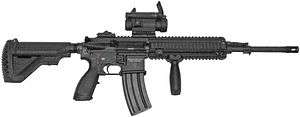 |
Used by infantry marksman, as well as various Australian special forces units. | |
| L1A1 Self-Loading Rifle | Battle rifle | 7.62×51mm NATO |  |
Used by the Australian Federation Guard with bayonet attachment. |
Precision rifles
| Name | Origin | Type | Calibre | Photo | Notes |
|---|---|---|---|---|---|
| SR-98 | Bolt action sniper rifle | 7.62×51mm | 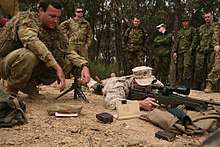 |
An Australian variant of the bolt action Accuracy International Arctic Warfare rifle, it is the standard-issue sniper rifle in the Australian Army and is chambered for 7.62×51mm. It replaced the Parker Hale Model 82 rifle in the late 1990s. Manufactured under licence in Australia by Thales Australia. | |
| AW50F | Anti-materiel rifle | .50 BMG |  |
The AW50F is the largest-bore variant of the Arctic Warfare sniper rifles suited to the anti-materiel role. It is chambered for the .50 BMG cartridge, and is primarily used with Raufoss Mk211 HEIAP rounds. The AW50F was designed with an Australian-designed and manufactured barrel. | |
| Blaser 93 Tactical 2 | Bolt Action Sniper rifle | .338 Lapua Magnum | 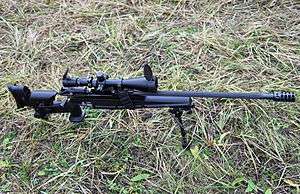 |
a straight-pull bolt-action sniper rifle chambered in .338 Lapua Magnum. The rifle has been observed in service with special forces and infantry units in Afghanistan. | |
| Heckler & Koch HK417 | Marksman Rifle System | 7.62×51mm NATO | 'Marksman Rifle System' used by infantry and special forces units to fill the gap between a sniper rifle and 5.56mm derivatives.[37] | ||
| SR-25 | semi-automatic | 7.62×51mm | 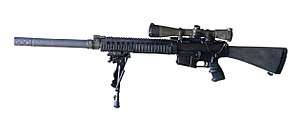 |
A semi-automatic 7.62×51mm sniper rifle. It has recently been observed in service with reconnaissance and special forces units of the Australian Army. It has seen service in Iraq, Afghanistan and East Timor. | |
| Mk 14 Enhanced Battle Rifle (M14EBR) | Designated marksman rifle | 7.62×51mm NATO | 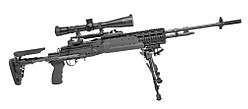 |
Small numbers borrowed from American forces[38] were used by Australian special forces in Afghanistan. | |
| Barrett M82 | Anti-materiel Sniper Rifle | .50 BMG |  |
A semi-automatic sniper and anti-materiel rifle chambered in .50 BMG[39] |
Machine guns
| Name | Origin | Type | Calibre | Photo | Notes |
|---|---|---|---|---|---|
| F89 Minimi | Light machine gun | 5.56×45 mm NATO | 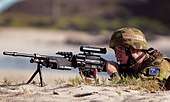 |
The Army's standard light machine gun chambered for 5.56×45 mm NATO. The F89 is also manufactured under licence in Australia by Thales Australia. | |
| Maximi | Light machine gun | 7.62×51mm NATO | 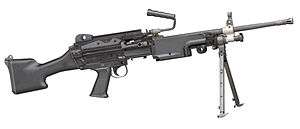 |
The 7.62×51mm NATO model of the Minimi is also in limited service.[40] | |
| FN MAG 58 | General-purpose machine gun | 7.62×51mm NATO | 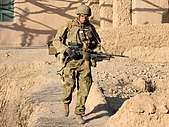 |
The Army's general purpose machine gun chambered for 7.62 × 51 mm NATO. It replaced the M60 machine gun. | |
| Browning M2HB-QCB | Heavy machine gun | .50 BMG | 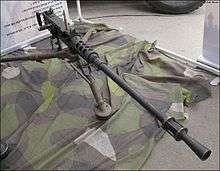 |
Heavy machine gun not used at the infantry section level but rather as a heavy support weapon usually mounted on vehicles. It uses the .50 BMG cartridge and has an effective range in excess of 2,000 metres. |
Pistols
| Name | Origin | Type | Calibre | Photo | Notes |
|---|---|---|---|---|---|
| Self-Loading Pistol 9 millimetre Mark 3 | Semi-automatic pistol | 9mm | 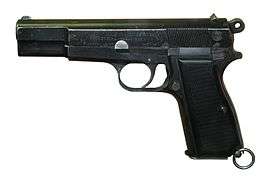 |
The Self-Loading Pistol 9 millimetre Mark 3[41] is the standard issue service pistol of the Australian Defence Force. | |
| Heckler & Koch USP | Semi-automatic pistol | 9mm | 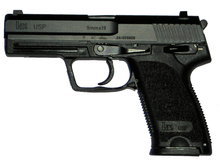 |
The Heckler & Koch USP is used by various special forces units. |
Submachine guns
| Name | Origin | Type | Calibre | Photo | Notes |
|---|---|---|---|---|---|
| Heckler & Koch MP5 | Submachine gun | 9mm | 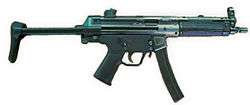 |
Primarily used by special forces units. |
Shotguns
| Name | Origin | Type | Calibre | Photo | Notes |
|---|---|---|---|---|---|
| Remington Model 870 and 870P[42] | Shotgun | 12-gauge | 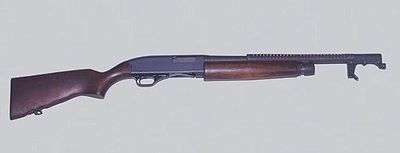 |
Used by both Special Forces and Military Police personnel. It is also used in specific roles within the infantry. |
Grenade launchers
| Name | Origin | Type | Calibre | Photo | Notes |
|---|---|---|---|---|---|
| M203 grenade launcher | grenade launcher | 40×46mm | 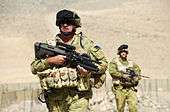 |
Attaches to the F88 (RM Equipment M203PI) and M4 (Colt M203-A1) rifles. | |
| Mk 19 AGL | automatic grenade launcher | 40×53mm | 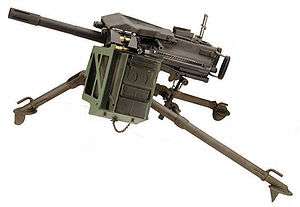 |
Automatic grenade launcher that fires grenades at a cyclic rate of 325-375 rounds per minute, giving a practical rate of fire of 60 rounds per minute (rapid) and 40 rounds per minute (sustained). Usually vehicle mounted by Australian special forces units. | |
| Mk 47 Striker LWAGL | automatic grenade launcher | 40×53mm | 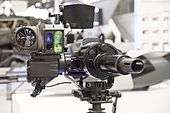 |
Mk 47 Mod 1 Lightweight automatic grenade launcher (LWAGL) is 36% of the weight of the Mk 19, has a further range than the Mk 19 and is fitted with Lightweight Video Sight (LVS2) sighting system. It will be issued to infantry battalions from late 2016 and to Special Operation Command units from early 2017.[43] |
Anti-armour
| Name | Origin | Type | Calibre | Photo | Notes |
|---|---|---|---|---|---|
| 66 mm Short-Range Anti-Armour Weapon (M72 LAW) | anti-tank rocket launcher | 66mm | 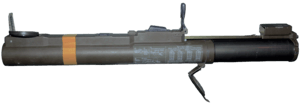 |
A single shot disposable anti-armour weapon | |
| L14A1 Carl Gustav Medium Direct Fire Support Weapon | recoilless rifle | 84mm | 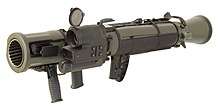 |
Primarily used in the anti-armour role. M4 variant ordered in 2018 and to be delivered in 2020.[44] | |
| Javelin Anti-Tank Guided Missile (ATGM) | guided anti-armour missile | 127mm | .jpg) |
Mortars
| Name | Origin | Type | Calibre | Photo | Notes |
|---|---|---|---|---|---|
| F2 81mm Mortar | Mortar | 81mm | 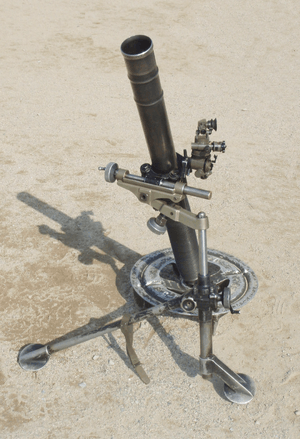 |
Grenades and anti personnel mines
| Name | Origin | Type | Detonation | Photo | Notes |
|---|---|---|---|---|---|
| F1 fragmentation hand grenade | Frag grenade | Fuse | Manufactured by Thales Australia. It has a lethal range of 6 m (20 ft) and has a fuse time of 4.5 to 5.5 seconds. | ||
| M18A1 Claymore Antipersonnel Mine | Anti-personnel mine | Remote | 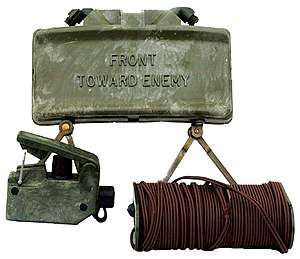 |
It is called an "Anti-Personnel Device" due to the Commonwealth of Australia agreeing not to use mines of any type. |
Bayonets
| Name | Origin | Type | Photo | Notes |
|---|---|---|---|---|
| M9 Bayonet | Bayonet |  |
The Army's primary combat knife used by all personnel and attached on the F88 Austeyr and the M4 carbine. |
Combat uniform of the Australian Army
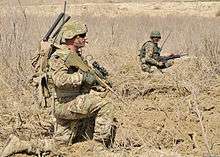
There are three major combat uniforms worn by the Australian Defence Force, they are:
- Disruptive Pattern Combat Uniform - DPCU is the standard combat uniform worn in terrains that feature green and brown-shaded flora. The pattern has been in service since the late 1980s.
- Disruptive Pattern Desert Uniform - DPDU is the Desert Combat uniform worn by Australian Defence Force personnel in theatres where the terrain is arid. It uses the same pattern as DPCU, but with the colours changed to suit the desert terrain. This uniform was instituted in the early 2000s, to meet the need for personnel serving overseas in Southwest Asia
- MultiCam - in late 2010, the ADF announced that Multicam will be the standard pattern for all regular Australian Army personnel in Afghanistan after trials were conducted by special operations units. Multicam, it is said, provided "... troops with greater levels of concealment across the range of terrains in Afghanistan – urban, desert and green." Previously, depending upon the terrain, Australian troops had to alternate between green and desert colored DPCUs.[45][46] Furthermore, the Defence Material Organisation has since announced that they had obtained a licence from Crye Associates to locally produce Multicam and for a new uniquely Australian pattern to be developed by Crye to replace DPCU uniforms.[47]
The current issue of DPCU is known as 'DPCU-NIR' - or Disruptive Pattern Combat Uniform - Near Infra-Red. The Defence Science and Technology Organisation has developed materials for use in combat uniforms which will reduce night-vision detection, and it has been integrated into this uniform, which also sports a new cut and shape, the NATO-style front rank epaulette, zip-fastening, sleeve pockets and Velcro tabs.[48]
Future equipment
Infantry weapons
The Army has begun to roll out their new state of the art rifle, the Enhanced F88 (EF88). The new rifle has several new features including improved modularity featuring extended accessories rail, a fixed barrel, bolt catch release and a black paint scheme. It was confirmed in July 2015 that the contract for 30,000 EF88 rifles had been approved with full roll out starting in 2016. 2,500 Steyr Mannlicher SL40 grenade launchers have also been ordered.[49]
The Army had previously planned on replacing the F88 with the Advanced Individual Combat Weapon (AICW) by 2010–2012. The most notable feature of the AICW is a grenade launcher with 3 stacked rounds that uses electricity to fire off the grenade. The AICW had aimed to provide the infantry soldier with the ability to fire multiple grenades without having to reload, and to switch between 5.56 mm ballistic rounds and 40 mm grenades without changing sights, trigger or stance, giving the operator more versatility and reduced reaction times in combat. The AICW has all but disappeared from the Army's sights and it is unlikely to ever make a return. The company responsible for the ACIW, Metal Storm Limited was placed in voluntary administration in 2012.[50]
The Army decided to procure the Mk 47 Striker 40 mm lightweight automatic grenade launcher in mid-2015, and plans to begin receiving units within one year.[51]
Armoured vehicles
In December 2011, the Thales Hawkei PMV (Protected Military Vehicle) was selected as the preferred tender for the Army's requirement of a light 4x4 armored car with a potential order for 1300 vehicles.[52] The seven-tonne Hawkei has been described as a 'baby' variant of the Bushmaster[53] having been developed by the same manufacturer.
Under LAND 400 the ASLAV and M113s will be replaced, with the project to acquire a Combat Reconnaissance Vehicle (CRV), an Infantry Fighting Vehicle (IFV), a Manoeuvre Support Vehicle (MSV) and an Integrated Training System (ITS). The ASLAV fleet is planned to be replaced from 2020, and the M113s from 2025.[54] On 19 February 2015 the tender was opened for the replacement of the ASLAV, listing a requirement for up to 225 armored vehicles to provide the future mounted combat reconnaissance capability.[55] The remaining requirements of the project will be confirmed by the upcoming Defence White Paper; however, it is expected to include an infantry fighting vehicle—a capability currently only partly provided by the in-service M113AS4 Armoured Personnel Carrier—as well as a manoeuvre support vehicle, and an integrated training system.[56] The project is valued at more than $10 billion and is expected to acquire approximately 700 vehicles.[57]
Aircraft
The Army is reorganising its aviation element, through the purchase of 22 ARH Tiger attack helicopters and 30 MRH 90 Taipan utility helicopters (30 helicopters out of a total purchase of 46, which will be divided between Army, Fleet Air Arm and a joined MRH 90 training base). Furthermore, 7 CH-47F Chinook heavy lift helicopters will be purchased to replace the Army's five remaining CH-47D Chinook helicopters. In addition, the Army will also acquire a number of UAVs (including a number of Boeing ScanEagles and 18 RQ-7 Shadow) which will equip the 20th Surveillance and Target Acquisition Regiment, at Enoggera Barracks, Queensland.[58] Smaller UAVs being trialed include the AeroVironment Wasp III and Black Hornet Nano.[59]
Previously it was planned that the MRH-90 would eventually replace all of the Army's Black Hawks, with the Black Hawk fleet planned to be reduced to 18 operational aircraft in 2014–15 as part of the phased withdrawal of the type from service.[60] However, in December 2015 it was announced that 20 Black Hawks will remain in service with the 6th Aviation Regiment until the end of 2021 to provide aviation support to special forces.[30]
The Army as part of a joint program with the RAN under Air 9000 Phase 7B are seeking future advanced training and light support helicopters. The helicopters being offered by industry are: Eurocopter EC-135 (from Boeing-Thales), Bell 429 (Raytheon-Bell) and Agusta A109 (from BAE-CAE-AgustaWestland).[61]
References
- ↑ "Australia – M88A2 Hercules Heavy Recovery Vehicles" (Press release). Washington, D.C. Defense Security Cooperation Agency. 26 January 2015. Retrieved 4 April 2015.
- 1 2 "Australian Armoured Vehicle Programs to 2030" (PDF).
- ↑ McMahon, Amelia (12 March 2018). "LAND 400 Phase 2 decision revealed".
- ↑ "Queensland trounces Victoria in bid for $5 billion Army deal". 14 March 2018.
- 1 2 Houston and Handel, Bill and Paul (9 April 2015). "Half a century's service" (PDF). Army: The Soldiers' Newspaper (1348 ed.). Canberra, Australia: Department of Defence. ISSN 0729-5685.
- ↑ "M113AS4 Armoured Personnel Carrier". Australian Army. Retrieved 8 August 2016.
- ↑ "Australia issues tender for Land 400 Phase 3". www.janes.com. Retrieved 2018-08-30.
- ↑ Dominguez, Gabriel (17 August 2018). "Australia orders 211 Boxer wheeled armoured vehicles". www.janes.com. London: IHS Janes. Retrieved 18 August 2018.
- ↑ "Joint media release - Prime Minister, Minister for Defence Industry and Minister for Defence - New Vehicles to protect our troops and create 1450 jobs". 14 March 2018. Retrieved 15 March 2018.
- ↑ "land400 - Capability Acquisition and Sustainment". www.defence.gov.au.
- ↑ "More vehicles on the way". Army News: The Soldiers' Newspaper. Canberra: Australian Department of Defence. 26 May 2011. p. 16.
- ↑ Tufrey, LS Jayson (22 October 2015). "Our vehicle of the future" (PDF). Army: The Soldiers' Newspaper (1362 ed.). Canberra, Australia: Department of Defence. ISSN 0729-5685.
- ↑ "G Wagon". Australian Army. Retrieved 8 August 2016.
- ↑ Ridgway, Steve (13 November 2008). "$350m wagon deal" (PDF). Army: The Soldiers' Newspaper (1202 ed.). Canberra, Australia: Department of Defence. ISSN 0729-5685.
- ↑ "G-wagon booklet" (PDF). Australian Army. Archived from the original (PDF) on 5 January 2016. Retrieved 8 August 2016.
- ↑ "RMMV HX", Jane's, 30 August 2018, retrieved 30 August 2016
- ↑ "Major contract extension expected", Rheinmetall, 25 July 2018, retrieved 30 August 2016
- ↑ "Australian army soon to get Nary vehicles". United Press International. 21 July 2011. Retrieved 5 December 2015.
- ↑ Minister for Defence Materiel Jason Clare (13 December 2012). "Minister for Defence Materiel – New Special Operations vehicle prototype delivered" (Press release). Department of Defence.
- ↑ "Contract signed for Special Operations Vehicles". Capability Acquisition and Sustainment Group (CASG). Department of Defence. Retrieved 16 September 2016.
- ↑ "Supacat to deliver 89 Special Operations Vehicles – Commando under $105m contract for JP2097 Ph 1B (REDFIN) Program". Supacat (Press release). 19 August 2014. Retrieved 16 September 2016.
- 1 2 Morley, Sgt Dave (12 February 2015). "Specialists rest easy" (PDF). Army: The Soldiers' Newspaper (1344 ed.). Canberra, Australia: Department of Defence. ISSN 0729-5685. Retrieved 26 November 2016.
- 1 2 "Naming of RACT watercraft (Policy statement)" (PDF). Royal Australian Corps of Transport. Royal Australian Corps of Transport. 24 October 2006. Retrieved 26 November 2016.
- ↑ Bergmann, Kym (23 October 2010). "Push is on to bring out the big guns". The Australian. News Ltd. Retrieved 4 January 2011.
- ↑ "ADM: Weapons: Anti-air capability study looks to futuristic technologies | ADM Sep 08". www.australiandefence.com.au. Retrieved 3 February 2016.
- ↑ "Australia Orders Carl Gustav Ammunition and Bolide Missiles". www.deagel.com. Retrieved 3 February 2016.
- ↑ Greene, Andrew (10 April 2017). "Christopher Pyne defends decision to award $2b missile contract without competition". ABC News (Australia). Retrieved 10 April 2017.
- ↑ "$2 billion for NASAMS GBAD system". Australian Defence Magazine. 10 April 2017. Retrieved 10 April 2017.
- 1 2 "World Air Forces 2015" (PDF). Flightglobal. Retrieved 19 July 2015.
- 1 2 3 Kerr, Julian (1 December 2015). "Australian Army to extend Black Hawk service lives for special forces use". IHS Jane's Defence Weekly. Retrieved 3 December 2015.
- ↑ "Three more CH-47F helicopters delivered ahead of schedule in FMS deal". Australian Aviation. 27 June 2016. Retrieved 30 June 2016.
- ↑ Australian National Audit Office (2018). "AIR 9000 Phase 5C Project Data Summary Sheet". 2016–17 Major Projects Report - Department of Defence (PDF). Canberra: The Auditor-General. ISBN 9781760333256. ANAO Report No.26 2017–18. Retrieved 29 August 2018.
- ↑ "Minister for Defence – New training system for ADF helicopter crews" (Press release). Department of Defence. 23 October 2014. Archived from the original on 25 August 2016. Retrieved 1 August 2016.
- ↑ McLennan, Benjamin (18 June 2015). "'Exceptional Weapon': 1RAR first to receive Enhanced F88". Army News. DefenceNews.com.au. p. 3. Retrieved 20 June 2015.
- ↑ Wong, Kelvin (4 August 2015). "Thales F90 assault rifle poised to enter mainstream Australian service". IHS Jane's 360. Retrieved 3 December 2015.
- ↑ "New assault rifles for Australian commando force". International Defence Digest. Jane's International Defence Review. 5 September 2000. Retrieved 24 August 2012.
The 4th Battalion, Royal Australian Regiment (commando) (4RAR) (Cdo) will receive several hundred Colt M4A5 5.56mm assault rifles ...
- ↑ Juchniewicz, Nathan (21 July 2011). "New weapon to go the distance". Army News: The Soldiers' Newspaper. Canberra: Australian Department of Defence. p. 3. Retrieved 27 August 2011.
- ↑ Armstrong, Dave (2012). "The M14 EBR - a Continuing Evolution" (PDF). dtic.mil, slide presentation. Crane Division, Naval Surface Warfare Center (NSWC Crane). p. 9. Retrieved 6 June 2012.
The Australian SAS borrowed a quantity of MK 14 MOD 0 Rifles, one of which was used to earn a Victoria Cross by Corporal Ben Roberts-Smith in October of 2010. He had been providing Sniper Cover from the Air when his Assaulting Services were needed on the Ground.
- ↑ Davis, Sgt Mick (5 December 2013). "Snipers Hit the Mark: Snipers get fired up at SASR concentration in WA". Army (News). Directorate of Defence News. p. 11. Retrieved 23 December 2013.
- ↑ Juchniewicz N.; Manchip J. (12 May 2011). "Gun maximises combat power". Army News: The Soldiers' Newspaper. Canberra: Australian Department of Defence. p. 4. Retrieved 14 May 2011.
- ↑ "Self-Loading Pistol 9 millimetre Mark 3". Australian Army.
- ↑ "Threads Newsletter: Issue Four 2012" (PDF). Defence Materiel Organisation, Department of Defence, Australian Government. 2012. p. 3.
Confirming a new stock on the 870P shotgun meets the operator’s requirements.
- ↑ McLennan, Lt-Col Ben (21 April 2016). "Soldier lethality game changer" (PDF). Army: The Soldiers' Newspaper (1371 ed.). Canberra, Australia: Department of Defence. ISSN 0729-5685.
- ↑ Dominguez, Gabriel (5 September 2018). "Australia orders Carl-Gustaf M4 weapon systems". www.janes.com. London: Jane's IHS.
- ↑ New combat uniform makes troops job easier, Australian Department of Defence, 19 November 2010.
- ↑ Land Warfare Conference - Minister for Defence Materiel Archived 2 June 2011 at the Wayback Machine., Australian Department of Defence, 19 November 2010.
- ↑ New defence uniforms on the way, The Sydney Morning Herald, 30 May 2011
- ↑ Cloak of invisibility. Army News 22 April 2004.
- ↑ Kerr, Julian (6 July 2015). "Australia ready to sign EF88 Austeyr rifle contract". IHS Jane's Defence Weekly. Retrieved 23 July 2015.
- ↑ "Thales upgrades Austeyr rifle to meet ADF operational needs". Thales Australia. 29 October 2008. Retrieved 23 September 2009.
- ↑ NIOA wins 40mm grenade launcher contracts - Australiandefence.com.au, 28 July 2015
- ↑ "Minister for Defence and Minister for Defence Materiel – Project Overlander – LAND 121". Media release. Department of Defence. 12 December 2011. Retrieved 12 March 2012.
- ↑ "First look at Hawkei". bendigoadvertiser.com.au. Bendigo Advertiser. 3 October 2009. Retrieved 14 March 2012.
The baby brother of the Bushmaster, the Hawkei is a seven-tonne vehicle that has the same protection design as the highly successful Bushmaster.
- ↑ "Project LAND 400". Modernization Project. Australian Army. Retrieved 1 March 2015.
- ↑ "Australia officially opens up tender for next-generation light armoured vehicle". Armyrecognition.com. 19 February 2015. Retrieved 21 February 2015.
- ↑ "Minister for Defence – LAND 400 Phase 2 – Mounted Combat Reconnaissance Capability" (Press release). Department of Defence. 19 February 2015. Archived from the original on 21 February 2015. Retrieved 21 February 2015.
- ↑ "South Australia Primed to Build Australian Army Vehicles" (PDF) (Press release). Government of South Australia. 19 February 2015. Retrieved 1 March 2015.
- ↑ "Army buys 18 Shadow UAVs". Australian Aviation. Phantom Media. 2 August 2010. Retrieved 13 October 2011.
- ↑ Coyne, Allie (3 July 2015). "Australian Army tests out drones for surveillance". IT News. Retrieved 1 September 2016.
- ↑ "S-70A-9 Black Hawk Weapons". Defence Materiel Organisation. Department of Defence. Retrieved 8 November 2014.
- ↑ "Boeing/Thales settle on EC135 for ADF bid". Australian Aviation Magazine. 30 January 2012. Retrieved 8 May 2012.
External links
| Wikimedia Commons has media related to Weapons of Australia. |
- Manufacturing process of the F88 rifle - Army News, 6 September 2007.
- "Improving In-Service Small Arms Systems – An Australian Experience" (PDF). Defense Technical Information Center (dtic.mil). Thales Australia Limited. 1 June 2011. Archived from the original (PDF) on 20 October 2016. Retrieved 13 January 2012.
|}
